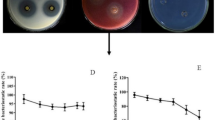Abstract
Bacillus coagulans TQ33, isolated from skimmed milk powder, displays strong antifungal activity against plant pathogenic fungi. The antifungal compound of the B. coagulans TQ33 culture was extracted by thin-layer chromatography and column chromatography, and its structure was elucidated based on HPLC, LC-MS, and NMR analysie. The antifungal compound was identified as phenyllactic acid (PLA), and it was found to have a minimum inhibitory concentration on Phytophthora drechsleri Tucker of 18 mg/mL. Bio-control activity tests indicated that PLA has a wide spectrum of antagonistic effects against Fusarium oxysporum, Botrytis cinerea, Glomerella cingulata, Penicillium citrinum, Penicillium digitatum, particularly against F. oxysporum. PLA is the most notable antimicrobial compound with broad and effective antimicrobial activity against both bacteria and fungi that has been isolated and identified to date. These results indicate that B. coagulans TQ33 has the potential for application in biological pesticides.





Similar content being viewed by others
References
Abada E (2008) Isolation and characterization of an antimicrobial compound from Bacillus coagulans. Anim Cells Syst 12:41–46
Dolin BJ (2009) Effects of a proprietary Bacillus coagulans preparation on symptoms of diarrhea-predominant irritable bowel syndrome. Methods Find Exp Clin Pharmacol 31:655–659
Endres JR, Clewell A, Jade KA, Farber T, Hauswirth J, Schauss AG (2009) Safety assessment of a proprietary preparation of a novel Probiotic, Bacillus coagulans, as a food ingredient. Food Chem Toxicol 47:1231–1238
Endres JR, Qureshi I, Farber T, Hauswirth J, Hirka G, Pasics I, Schauss AG (2011) One-year chronic oral toxicity with combined reproduction toxicity study of a novel probiotic, Bacillus coagulans, as a food ingredient. Food Chem Toxicol 49(5):1174–1182
Gerez CL, Carbajo MS, Rollan G, Leal GT (2010) Inhibition of citrus fungal pathogens by using lactic acid bacteria. J Food Sci 75:M354–M359
Hun L (2009) Bacillus coagulans significantly improved abdominal pain and bloating in patients with IBS. Postgrad Med 121:119–124
Hyronimus B, Urdaci CM (1998) Coagulin, a bacteriocin-like inhibitory substance produced by Bacillus coagulans I4. J Appl Microbiol 85:42–50
Jaroszewski DE, Halabi WJ, Blair JE, Coakley BJ, Wong RK, Parish JM, Vaszar LT, Kusne S, Vikram HR, Lanza LA, Arabia FA (2009) Surgery for Pulmonary coccidioidomycosis: a 10-year experience. Ann Thorac Surg 88:1765–1772
Kuhajek JM, Jeffers SN, Slattery M, Wedge DE (2003) Rapid microbioassay for discovery of novel fungicides for Phytophthora spp. Phytopathology 93(1):46–53
Lavermicocca PF, Valerio A, Evidente S, Lazzaroni S, Corsetti A, andGobbetti M (2000). Purification and characterization of novelantifungal compounds from sourdough Lactobacillus plantarum strain21B. Appl Environ Microbiol 66: 4048–4090
Li XF, Jiang B, Pan BL (2007) Biotransformation of phenylpyruvic acid to phenyllactic acid by growing and resting cells of a Lactobacillus sp. Biotechnol Lett 29(4):593–597
Matsumo Y (1990) Transformation of Bacillus subtilis antifungal-antibiotic iturin procedures with isolated antibiotic resistance plasmid. J Appl Microbiol 38:13–21
Park SC, Kim JY, Lee JK, Hwang I, Cheong H, Nah JW, Hahm KS, Park Y (2009) Antifungal mechanism of a novel antifungal protein from pumpkin rinds against various fungal pathogens. J Agric Food Chem 57:9299–9304
Prema P, Smila D, Palavesam A, Immanuel G (2008) Production and characterization of an antifungal compound (3-Phenyllactic Acid) produced by Lactobacillus plantarum strain. Food Bioprocess Tech 3:379–386
Raspor P, Miklic MD, Avbelj M, Cadez N (2010) Biocontrol of grey mould disease on grape caused by Botrytis cinerea with autochthonous wine yeasts. Food Technol Biotech 48:336–343
Riazi S, Wirawan RE, Badmaev V, Chikindas ML (2009) Characterization of lactosporin, a novel antimicrobial protein produced by Bacillus coagulans ATCC 7050. J Appl Microbiol 106:1370–1377
Schnurer J, Magnusson J (2005) Antifungal lactic acid bacteria as biopreservatives. Trends Food Sci Tech 16:70–78
Sjogren J, Magnusson J, Broberg A, Schnurer J, Kenne L (2003) Antifungal 3-hydroxy fatty acids from Lactobacillus plantarum MiLAB 14. Appl Environ Microb 69(12):7554–7557
Strange RN, Scott PR (2005) Plant disease: a threat to global food security. Annu Rev Phytopathol 43:83–116
Strom K, Sjogren J, Broberg A, Schnurer J (2002) Lactobacillus plantarum MiLAB 393 produces the antifungal cyclic dipeptides cyclo(L-Phe-L-Pro) and cyclo(L-Phe-trans-4-OH-L-Pro) and 3-phenyllactic acid. Appl Environ Microb 68(9):4322–4327
Wang HK, Hu Y, Shi J, Huang L, Zhang HP, Qi W (2011) Activity against plant pathogenic fungi of Lactobacillus plantarum IMAU10014 isolated from Xinjiang koumiss in China. Ann Microbiol 61(4):879–885
Wilson AR (2005) Epton Anti-bacterial activity of Lactobacillus plantarum strain SK1 against Listeria monocytogenes is due to lactic acid production. J Appl Microbiol 99:1516–1522
Zheng ZJ, Ma CQ, Gao C, Li FS, Qin JY, Zhang HW, Wang K, Xu P (2011) Efficient Conversion of Phenylpyruvic Acid to Phenyllactic Acid by Using Whole Cells of Bacillus coagulans SDM. PLoS One. doi:10.1371/journal.pone.0019030
Acknowledgments
Financial support provided by the National Natural Science Foundation of China (No. 30900961 and No. 20876116) and TianJin Social Science Planning Program (No. TJGLWT11-08) is gratefully acknowledged.
Author information
Authors and Affiliations
Corresponding author
Rights and permissions
About this article
Cite this article
Wang, H., Shen, F., Xiao, R. et al. Purification and characterization of antifungal compounds from Bacillus coagulans TQ33 isolated from skimmed milk powder. Ann Microbiol 63, 1075–1081 (2013). https://doi.org/10.1007/s13213-012-0564-y
Received:
Accepted:
Published:
Issue Date:
DOI: https://doi.org/10.1007/s13213-012-0564-y



